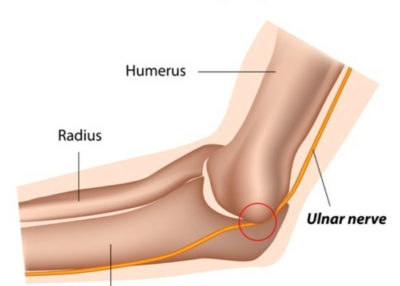Elbow Nerve Specialist

Are you experiencing pain, tingling, and a “falling asleep” or numb sensation in the little finger and ring finger? If so, you may have ulnar nerve entrapment, or a pinched nerve in your elbow. Also called cubital tunnel syndrome, ulnar nerve entrapment can occur in several places along the nerve path of the arm. Most symptoms are felt on the inside of the elbow and extend to the fingers of the hand. It is very important to visit a doctor at the onset of ulnar nerve compression symptoms to avoid muscle wasting. Ulnar nerve entrapment specialist, Doctor Riley J. Williams provides diagnosis as well as surgical and nonsurgical treatment options for patients in Manhattan, Brooklyn, New York City and surrounding areas who are experiencing the symptoms of a compressed or pinched elbow nerve. Contact Dr. Williams’ team today!
What is ulnar nerve entrapment?
The ulnar nerve is one of three main nerves of the arm. The ulnar nerve runs through the length of the arm and carries signals from the brain to the fourth and fifth fingers of the hand. This nerve courses from the base of the neck, along the inside of the arm, through the elbow and down to the fingers. Ulnar nerve entrapment is also known as cubital tunnel syndrome. An entrapped nerve is clinically the same as a pinched nerve. Entrapment of the ulnar nerve in the cubital tunnel of the elbow causes achiness, pain, tingling and numbness in the forearm and fingers. If left untreated, cubital tunnel syndrome can cause muscle loss in the hand and forearm. The site where the ulnar nerve

passes through the elbow (cubital tunnel) is narrow; the base of the tunnel is the bony portion of the medial epicondyle of the distal humerus. When the elbow is flexed, the ulnar nerve is stretched and compressed in the cubital tunnel, elbow extension reliefs this tension on the nerve. Though the cubital tunnel is the most common area of ulnar nerve entrapment in the arm, the nerve may be constricted in other areas of the arm as well.
What is cubital tunnel syndrome?
Cubital tunnel syndrome is ulnar nerve entrapment at the site of the medial epicondyle. The cubital tunnel is narrow and is comprised of a bony base and an inflexible ligamentous sleeve. The ulnar nerve travels behind the medial epicondyle in the cubital tunnel. Constriction of the ulnar nerve in the cubital tunnel typically is exacerbated by elbow flexion or bending. Cubital tunnel syndrome can result in pain, numbness and tingling in the forearm, hand and fingers; more severe cases can result in a loss of general motor function in the hand. Dr. Riley J. Williams, orthopedic elbow specialist serving Manhattan, Brooklyn, New York City, NY and surrounding areas has extensive experience in cubital tunnel syndrome and ulnar nerve entrapment.
What are the symptoms of cubital tunnel syndrome?
Individuals in the New York area who suffer from ulnar nerve entrapment or cubital tunnel syndrome often report the following symptoms:
- Forearm, hand and finger numbness and tingling
- Loss of motor skills in the hand
- Loss of dexterity
- Pinky and ring finger tingling/numbness
- Hand clumsiness
- Inability to hold things, resulting in dropping objects
- Worsening symptoms at night, stemming from sleeping in a flexed elbow position
- Pain or a burning feeling in the elbow or funny bone (inner elbow)
How is ulnar nerve entrapment/cubital tunnel syndrome diagnosed?
Dr. Williams performs a physical exam to check for tenderness, motor strength, and sensory changes in the hand, forearm and elbow. Longstanding cases of ulnar nerve can present with muscle distal to the elbow. A diagnostic test, such as an electromyogram (EMG) will demonstrate the functionality of the ulnar nerve and determine where nerve compression may be located.
How is cubital tunnel syndrome treated?
Non-surgical treatment:
Conservative methods are typically the first line of treatment for the ulnar nerve compression. Rest, elbow splints, and NSAIDs, such as ibuprofen, can help reduce pain and inflammation. Physical therapy may be implemented to strengthen the arm muscles; occupational therapy can fine tune motor skills.
Surgical treatment:
If nonoperative methods fail or if cubital tunnel syndrome symptoms are longstanding, surgery is indicated. Dr. Williams performs ulnar nerve decompression and transposition on an outpatient basis. Light sedation and regional anesthetic are used during this surgery. An incision is made at the medial elbow, and the nerve is mobilized and cleared of all adhesions. The nerve can be left in the decompressed tunnel, or moved to a new location that is usually anterior to the cubital tunnel. It typically takes six weeks to recover from ulnar nerve compression surgery.
For more information on ulnar nerve entrapment, cubital tunnel syndrome and the treatment options available, please contact the office of Riley J. Williams, MD, orthopedic elbow specialist serving Manhattan, Brooklyn, New York City, NY and surrounding areas.
